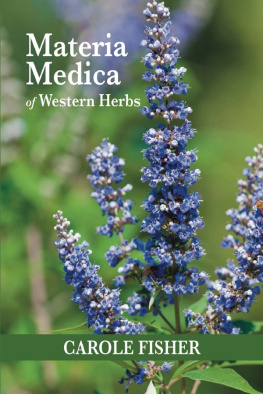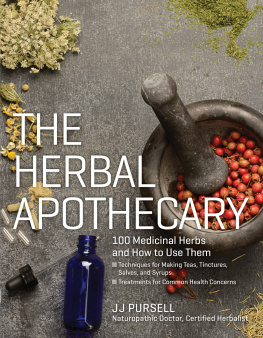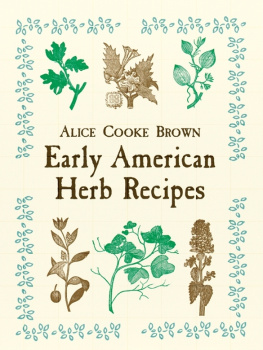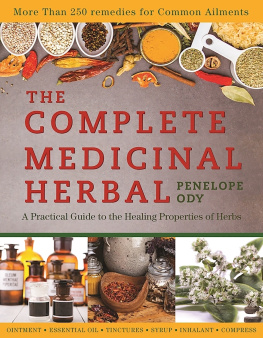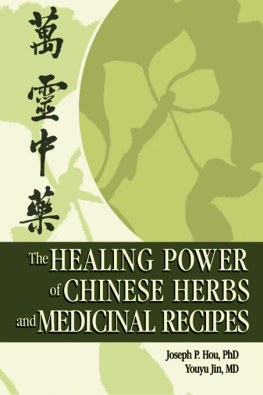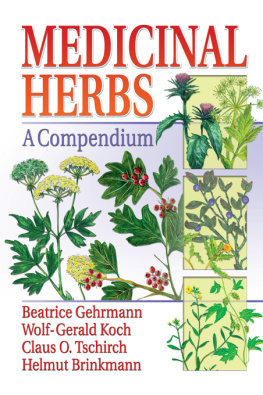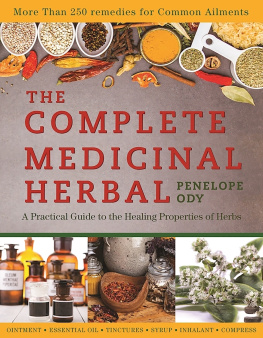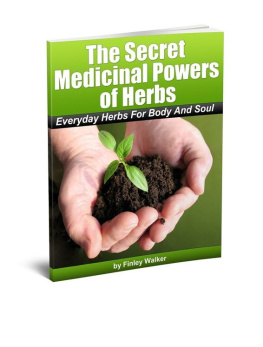I would like to recognize with gratitude those herbalists, past and present, who have contributed to the knowledge of herbal medicine and from whom we all benefit.
I thank Gilian Painter for supplying botanical information for each monograph and for her help with proof reading. Thanks also to Alan Esler for his earlier permission to use his diagrams of families, Apiaceae, Asteraceae and Lamiaceae and Isabel Sutherland for her help with redrawing some of the illustrations in the text.
Most illustrations have come from botanical works from last century and I gratefully acknowledge the work of W. H. Fitch and W. G. Smith in the Illustrations of The British Flora, L. Reeve and Co., London, 1880; Britton, N. L., and A. Brown. 1913. An illustrated flora of the northern United States, Canada and the British Possessions as well as Vol. 13 of the USDA-NRCS PLANTS Database from the same book, Medicinal Plants by R. Bently and H. Trimen, J. and A. Churchill, London. 1888. Also used were the works of older herbalists John Gerard, Leonhart Fuchs and Matthiolus.
CRC Press Inc. Boca Raton Florida for permission to use the illustrations of Harpagophytum from Handbook of Medicinal Plants by James Duke.
I would especially like to thank Doreen Marshall for her invaluable suggestions, careful compilation, dedication and patience in editing and producing this text. Without her enormous effort, wise contributions and unerring support my task would have been very much more difficult.
Finally my heartfelt thanks for the tremendous love and support I have received from my family.
APPENDIX IDEFINITIONS
Abortifacient: an agent which causes expulsion of the foetus
Acetylcholinesterase: the enzyme that metabolises acetylcholine a neurotransmitter responsible for many biochemical activities. A deficit of the transmitter can reduce memory function and inhibiting its enzymic breakdown is one approach used to treat Alzheimer's disease
Adaptogen: an agent which helps the body accommodate to stress or change from any source
Aglycone: molecule after the glycoside or sugar group has been removed
Alterative: an agent used to improve elimination of metabolic waste and in so doing restores normal body functions
Analgesic: an agent used to relieve pain, it can be administered orally or topically
Anaphrodisiac: an agent used to lessen sexual function and desire
Angiogenesis: the growth of new blood vessels, apart from its natural occurrence as part of maturation it also occurs during wound healing and metastatic tumour growth
Anhidrotic: an agent that reduces sweating
Anodyne: an agent used to soothe or ease pain
Antacid: an agent used to neutralise acid in the stomach
Anthelmintic: an agent used to expel or destroy parasitic worms in the gastro-intestinal tract
Anti-arthritic: an agent used to relieve and heal arthritic conditions
Anticancer: an agent that reduces the viability of cancer cells
Anticarcinogenic: an agent that reduces the frequency of occurrence of spontaneous or induced cancers
Anticatarrhal: an agent which reduces catarrh or excessive mucus secretion
Anticoagulant: an agent which slows or prevents clotting of blood
Antidote: an agent which counteracts or neutralises poison
Antilithic: an agent used to prevent the formation of calculi (stones) or gravel which can occur in the urinary system or gall bladder
Antimitotic: an agent which inhibits the division of cells i.e. mitosis
Antineoplastic: an agent that inhibits or destroys tumours
Antipyretic: an agent which prevents or reduces fevers
Antiscorbutic: an agent which prevents or cures scurvy
Antioxidant: an agent that prevents oxidation a process believed to be the initiating factor in the development of many disease conditions such as cancer and heart disease
Antiproliferative: an agent that inhibits cell or tissue growth
Antiseptic: an agent used to prevent, resist and counteract infection
Antispasmodic: an agent used to reduce or prevent excessive involuntary muscular contractions or spasms
Antisudorific: an agent which stops or prevents sweating
Antitussive: an agent which relieves or reduces coughing
Aperient: an agent which acts as a mild laxative
Aphrodisiac: an agent used to stimulate sexual interest
Apoptosis: a process of programmed cell death that occurs naturally. If defective it can lead to disease conditions i.e. its failure to occur is associated with the development of cancer whereas if it occurs excessively it can cause hypotrophy
Aquaretic: an agent that increases urine output by increasing renal blood flow and glomerular filtration without the accompanying loss of electrolytes
Astringent: an agent that contracts tissue, making them firmer and reducing their discharges
Asthenospermia: loss of or reduced sperm motility
Bacteriostatic: an agent that inhibits the growth or proliferation of bacteria without necessarily killing them
Bitter: an agent that has a bitter taste but also promotes digestive function and improves appetite
Bronchodilator: an agent which increases the diameter of the respiratory airways
Cardio-active: an agent which acts on the heart
Cardiotonic: an agent which has a beneficial action on the heart
Carminative: an agent which improves digestion and relieves the discomfort of flatulence and/or colic
Cathartic: an agent which causes evacuation of the bowels
Cholagogue: an agent which stimulates or aids the release of bile from the gall bladder
Choleretic: an agent which stimulates the production of bile in the liver
Co-mutagen: an agent that is not mutagenic itself but may become so in conjunction with other agents
Counter-irritant: an agent which when applied topically increases local circulation. It is used for the temporary relief of a deep seated painful irritation
Creatine kinase: an enzyme involved in regulation of energy in cells, it uses creatine to store energy from ATP. Levels may be elevated in pathologies like cancer due to increased energy demand so that its inhibition may constitute a therapeutic approach to disease
Cytotoxic: an agent that is toxic to cells causing their death
Demulcent: an agent that is used internally to sooth and protect irritated tissues and surfaces
De-obstruent: an agent that removes obstructions from the body by improving the normal channels of elimination
Depurative: an agent which promotes the natural channels of elimination
Desmutagen: an agent that reduces the damage caused to DNA by a mutagen
Diaphoretic: an agent that increases perspiration and elimination through the skin, often used to reduce temperature in fevers
Diuretic: an agent that increases the production and flow of urine
Dyssomnia: sleep disorder affecting the ability to go to sleep or stay asleep
Dysthymia: defined as a chronic mood disorder, manifesting as depression alternating with feeling normal
Emetic: an agent that induces vomiting
Enterotoxin: an agent that is toxic in the gastrointestinal tract and may cause vomiting, abdominal pain and/or diarrhoea

